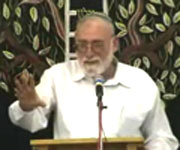Beit Midrash
- Sections
- Chemdat Yamim
- P'ninat Mishpat
Ruling: There is much discussion among contemporary dayanim whether or not one accused of causing damage for which he is insured needs to go to beit din if their decision will not obligate his insurance company. Even according to the opinions that he does not need to come to beit din, in this case there is a need for adjudication in beit din because pl is also demanding compensation for the possible raise in premium, which he cannot demand of the insurance company. If we will decide that def is obligated to pay, we will deal with the question of whether he has to pay himself or whether he can be covered by the insurance company if the courts obligate them.
[We will start looking into the question of responsibility for the damage, with general sources, and will continue with more sources and analysis of what happened next time.]
The Rosh (Shut Harosh 101:5) rules that one who damages by means of the horse he is riding pays under the category of a person’s damage (as opposed to, for example, the category of "an ox which damages"). The Aruch Hashulchan (Choshen Mishpat 378:20) rules that the same is true of one who is driving a horse-drawn wagon, and the same is true of driving a car.
There is a machloket how to apply the guidelines regarding collisions (which are discussed in Bava Kama 48b). According to Rashi (ad loc.), if either, both parties were in a position they were permitted to be in or both were in a position they were not allowed to be in, if one caused damage by an action, he is obligated even if he did so accidentally, and if he caused damage by failing to do something, he is exempt. Even if one was in the position properly and the other improperly, but the one who was there properly was aware of the presence of the other, if the proper one damaged by an action, he is obligated, and if by a lack of action, he is exempt. According to the Rambam (Chovel 6:3), in all the cases, if one damaged purposely or through negligence, he is obligated, and if he damaged without negligence, he is exempt. In one place (CM 378:6), the Shulchan Aruch rules like the Rambam, whereas in another (ibid. 7), regarding both being in the same category of appropriateness of presence, he rules like Rashi. Most Acharonim understand the Shulchan Aruch as having a hybrid position. It comes out that in our case, if def was in the right place and pl was not, def will be exempt; if they were of the same category, then if def saw pl, he would be obligated for the collision.

P'ninat Mishpat (801)
Beit Din Eretz Hemda - Gazit
719 - Why Did they Stop Working?
720 - Car Accident – part I
Load More

P'ninat Mishpat: How Far Does a Lien Go?
based on ruling 83097 of the Eretz Hemdah-Gazit Rabbinical Courts
Beit Din Eretz Hemda - Gazit | Shevat 5784

P'ninat Mishpat: Late and Flawed Apartment
based on ruling 82174 of the Eretz Hemdah-Gazit Rabbinical Courts
Beit Din Eretz Hemda - Gazit | Kislev 5786

P'ninat Mishpat: Rent of an Apartment Without a Protected Room
based on ruling 84036 of the Eretz Hemdah-Gazit Rabbinical Courts
Beit Din Eretz Hemda - Gazit | Iyar 5784

P'ninat Mishpat: Smoking Rights in a Rental? – part III
based on ruling 85076 of the Eretz Hemdah-Gazit Rabbinical Courts
Beit Din Eretz Hemda - Gazit | Tishrei 5786

Beit Din Eretz Hemda - Gazit

Who Breached the Contract? – part IV
Based on ruling 81087 of the Eretz Hemdah-Gazit Rabbinical Courts
Iyar 20 5783

Payment for Not Clearing Warehouse On Time – part II
based on ruling 75076 of the Eretz Hemdah-Gazit Rabbinical Courts
Av 20 5780

Raffle of Property in Eretz Yisrael for Tzedaka
Igrot Hare’aya – Letters of Rav Kook: – #220
18 Sivan 5784























